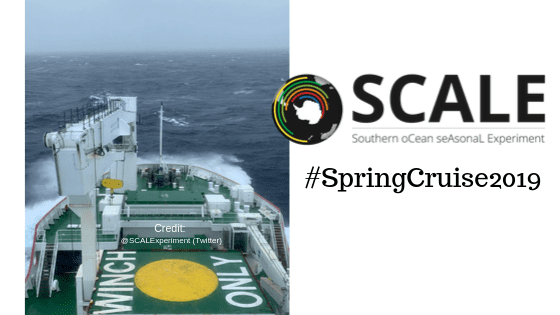On 12 October 2019, the S.A. Agulhas II departed on the first ever cruise to the Marginal Ice Zone during spring. This is a very exciting cruise with 97 participants onboard, representing 17 nationalities and 19 different scientific institutions.
Scientific institutions taking part in this dedicated science expedition, funded by the Department of Science and Technology (DST) through the National Research Foundation (NRF):
1. University of Cape Town
2. Stellenbosch University
3. South African Weather Service
4. Cape Peninsula University of Technology
5. Council for Scientific and Industrial Research
6. Department of Environment, Forestry and Fisheries
7. BirdLife South Africa
8. Plymouth Marine Laboratory
9. University of Exeter
10. University of Gothenburg, Sweden
11. University of Pretoria
12. University of Brest – LEMAR – IUEM
13. The University of Melbourne, Australia
14. University of Adelaide, Australia
15. Uppsala University, Sweden
16. Alfred Wegener Institute
17. Florida State University
18. New York University Abu Dhabi
19. Old Dominion University
This 47 day long cruise is managed by Dr Thomas Ryan-Keogh (CSIR), Chief Scientist onboard the vessel and by A/Prof Marcello Vichi (UCT) as land-based Chief Scientist.
The participants are distributed over 19 different teams onboard, covering all the aspects of the SCALE science plan:
| Team | Lead PI | Onboard Team Leader |
|---|---|---|
| BIRDS | Azwianewi Makhado | Derek Engelbrecht |
| DMS | Tom Bell | George Manville |
| CO2 | Pedro Monteiro | Mutshutshu Tsanwani |
| GLIDERS | Sarah Nicholson Pedro Monteiro Sebastian Swart | Louise Biddle Josh Huysamen |
| IRON | Thato Mtshali | Thato Mtshali |
| METEO | Christo Rautenbach Marc de Vos | Mardene de Villiers |
| MICROBIO | Thulani Makalanyane | Jarishma Gokul |
| NATM | Katye Altieri | Kurt Spence |
| NOCE | Sarah Fawcett | Raquel Flynn |
| OCE | Shared | Tommy Ryan-Keogh |
| PLANKTON | David Walker | Simone Louw |
| PLASTICS | Peter Ryan | Eleanor Weideman |
| PRODUCTION | Sandy Thomalla | Tommy Ryan-Keogh |
| SEAICE | Sebastian Skatulla Marcello Vichi Tokoloho Rampai Amit Mishra | Justin Pead |
| SEALS | Mia Wege | Marthan Bester |
| TRACEX | Alakendra Roychoudhury Susanne Fietz | Jan-Lukas Menzel |
| VIBRATION | Annie Bekker | Martinique Engelbrecht |
| WAVE | Alessandro Toffoli Clare Eayrs | Alberto Alberello Clare Eayrs |
| WHALES | Ken Findlay | Elisa Seyboth |
Meet Dr Thomas (Tommy) Ryan-Keogh:
Here is a summary of the integrated scientific themes of SCALE:
SEA ICE DYNAMICS AND AIR-SEA-ICE FLUXES
Antarctic sea ice shows a large year to year variability which is not completely captured by forecasting and climate models. Understanding ice mechanics, composition and movement is essential for ice charting and predictive models. The exchange of gases, aerosols, heat and momentum between the atmosphere and ocean through the sea ice is a key factor influencing long-term climate variability and trends. These fluxes are critical to understanding the links between carbon and climate, aerosols and albedo and the influence of terrestrial particles on ocean biogeochemistry.
BIOLOGICAL CARBON PUMP
Changes in climate and sea-ice distribution are likely to affect the composition, abundance, and productivity of phytoplankton, with feedbacks that threaten the ecosystem services they provide, namely sustaining biodiversity, fueling the food web and fisheries, and mediating global climate through an altered efficiency of the biological carbon pump.
PHYSICS TO TOP PREDATORS
The Southern Ocean is subject to strong frontal (meso to sub-mesoscale) activity due to the instability of the Antarctic Circumpolar Current. Nutrient pulses associated with frontal dynamics have the ability to propagate throughout the food chain from lower trophic levels (phytoplankton) to top predators (seabirds and marine mammals). The marginal ice zone environment is an essential habitat for seals and whales throughout the year, and its seasonal variability is a major driver of their feeding behaviour.
DECADAL CHANGES IN OCEAN INTERIOR
The Meridional Overturning Circulation is a global reaching system of surface and deep ocean currents. It is the primary mechanism for the transport and storage of heat, carbon, salt, freshwater and nutrients (including dissolved trace elements) between ocean basins; connecting the surface ocean and atmosphere with the huge reservoir of the deep sea.
DIGITAL TECHNOLOGY SOLUTIONS FOR POLAR ENGINEERING
To advance the scientific basis for ice-going vessels, the S.A. Agulhas II has been the subject of full-scale engineering measurements since 2012. These measurements focus on structural dynamics of the hull and propulsion systems, wave slamming and human comfort. The sensor infrastructure and advanced data analytics position the ship as an ideal platform to explore digital twin technology to assess the state and behaviour of the vessel in near real time within its operational context. These powerful platforms promise to advance education, research, innovation and industrial development related to shipping, oceans and polar research.
To find out more about SCALE (Southern oCean seAsonaL Experiment) and the key research objectives of the cruise – visit www.scale.org.za.
 Follow @SCALExperiment on Twitter for cruise updates.
Follow @SCALExperiment on Twitter for cruise updates.
Anché Louw, Antarctic Legacy of South Africa, 15 October 2019
Edited by : A/Prof Marcello Vichi (UCT)






